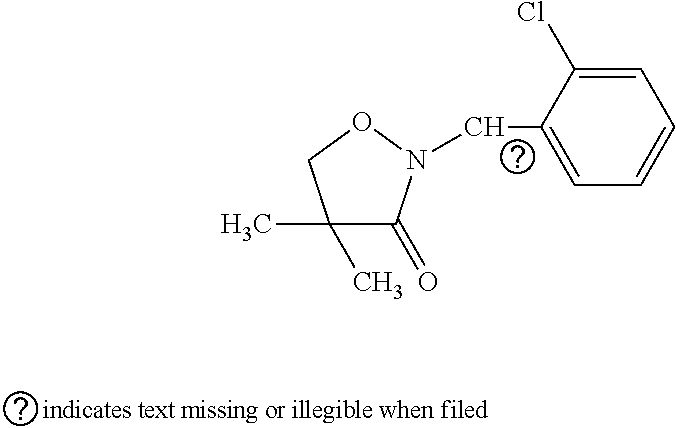Reduced vaporization compositions and methods
a composition and composition technology, applied in the field of reduced vaporization compositions and methods, can solve the problems of clomazone application, epinasty, whitening or bleaching, non-targeted crops, trees and/or decorative areas, etc., and achieve the effect of reducing the number of clomazone applications
- Summary
- Abstract
- Description
- Claims
- Application Information
AI Technical Summary
Benefits of technology
Problems solved by technology
Method used
Image
Examples
example 1
Formulation of Clomazone as a Simple Emulsion
[0059]A 1:1 solution of clomazone in soybean oil was prepared by dissolving 15.0 g of clomazone in 15.0 g of soybean oil. Subsequently, 0.17 g lecithin (Centrolex F) and 7.02 g deionized water were added to a 20 ml vial, and the lecithin / water mixture was sonicated for 1 minute 26 seconds at 50-70% power, using a Fisher Scientific Sonic Dismembrator with a model CL4 ultrasonic converter equipped with a ½ inch horn. The resulting nearly transparent lecithin dispersion was resonicated for 1 minute 49 seconds while 2.15 g of the 1:1 clomazone:soybean oil solution was added. This resulted in an opaque, white emulsion. The composition of this emulsion was 1.82% lecithin, 11.51% soybean oil, and 11.51% clomazone, by weight. The particle size of this emulsion was between 220 nm and 2 microns, and the product was stable for over a year as measured by the standard EPA accelerated formulation aging study. The product was stable for at least 3 month...
example 2
Formulation of Clomazone as an Emulsifiable Concentrate
[0060]Toximul 8242 (Steppan, 0.41 g), Toximul TA-5 (Steppan, 0.1 g), Atlox 4838B (Croda, 0.91 g), and a 1:1 mixture of clomazone:soybean oil (8.62 g) were combined in a beaker and mixed by simple shaking, resulting in a clear solution of 4.0% Toximul 8242, 1.0% Toximul TA-5, 8.8% Atlox 4838B, 43.1% soybean oil and 43.1% clomazone. When 1.0 ml of this concentrate was added to 99.0 ml of water in a capped 100 ml graduated cylinder, and the cylinder was inverted three times, a cloudy white oil in water emulsion was produced. After 24 hours standing, some settling occurred, but a simple, single re-inversion of the graduated cylinder restored the emulsion with ease.
example 3
Emulsfiable Concentrate Formulation
[0061]An emulsifiable concentrate was prepared by admixture of Synperonic A4 (0.15 g), Synperonic A20 (0.26 g), Atlox 4838B (0.50 g), Atlas G-5000 (0.10 g) and a 1:1 clomazone:soybean oil solution (9.01 g) resulting in an emulsifiable concentrate composed of 1.5% Synperonic A4, 2.5% Synperonic A20, 5.0% Atlox 4838B, 1.0% Atlas G5000, 45.0% soybean oil and 45.0% clomazone. As in Example 2, the resultant emulsifiable concentrate readily dispersed in water, and re-suspended, although this sample exhibited slightly more settling upon standing.
PUM
| Property | Measurement | Unit |
|---|---|---|
| temperature | aaaaa | aaaaa |
| temperature | aaaaa | aaaaa |
| temperature | aaaaa | aaaaa |
Abstract
Description
Claims
Application Information
 Login to View More
Login to View More - R&D
- Intellectual Property
- Life Sciences
- Materials
- Tech Scout
- Unparalleled Data Quality
- Higher Quality Content
- 60% Fewer Hallucinations
Browse by: Latest US Patents, China's latest patents, Technical Efficacy Thesaurus, Application Domain, Technology Topic, Popular Technical Reports.
© 2025 PatSnap. All rights reserved.Legal|Privacy policy|Modern Slavery Act Transparency Statement|Sitemap|About US| Contact US: help@patsnap.com



